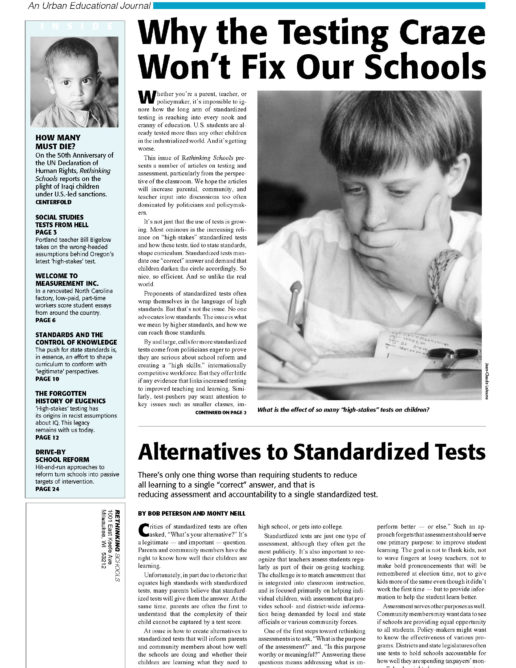Preview of Article:
Alternatives to Standardized Tests
There's only one thing worse than requiring students to reduce all learning to a single "correct" answer, and that is reducing assessment and accountability to a single standardized test.
Illustrator: Kathy Sloane
One of the more promising forms of assessment is what is known as “portfolio-based assessment.” The approaches to portfolios vary considerably, but they all rest on records kept by the teacher and on collections of the student’s work, called the “student portfolio.” During the school year, teachers and students gather work which shows student progress and achievement in various subjects such as English or science. Students are usually encouraged to reflect on the work that has been selected. Such reflection helps students think not only about what they have learned, but about their own learning processes, all of which contributes to the overall goal of improving student learning.
In some approaches, at the end of a marking period the teacher examines the portfolio and evaluates the work based on a scoring guide. Sometimes students or their peers also score their work. The teacher ultimately records a score on what is sometimes called a “learning record,” attaching evidence such as a writing sample or write-up of a science experiment. This approach is useful for the teacher and parent in determining how well a student is progressing. But, through what is known as “random sampling,” it also can be the basis for improved professional development and for school- and district-wide accountability.
Under “random sampling,” a number of the learning records and student portfolios are selected randomly from each classroom. An independent group — of teachers from other schools, members of the community, or a combination of both — reviews the records and portfolios. If there is a big difference between the conclusions of the independent readers and the classroom teacher, a third group might be called in or a larger sample might be taken from the classroom, in order to determine how well a particular teacher consistently applies the agreed upon assessment guidelines.
Approaches of this sort have been developed in Britain, Australia, and the United States, particularly in Vermont, which has instituted statewide assessment programs in math and writing based on student portfolios. Projects such as the Learning Record, based in California, and the Work Sampling System, based in Ann Arbor, are other examples.
This classroom-based approach has several advantages. For example, the evaluation is based on a wide range of student work done over a long period of time, rather than on a single, paper-and-pencil test taken over a few hours. Further, the approach encourages schools and districts to invest in the professional development of the teachers and outside evaluators, and it pushes teachers to reflect more consistently on the quality of student work in their classroom.</p

